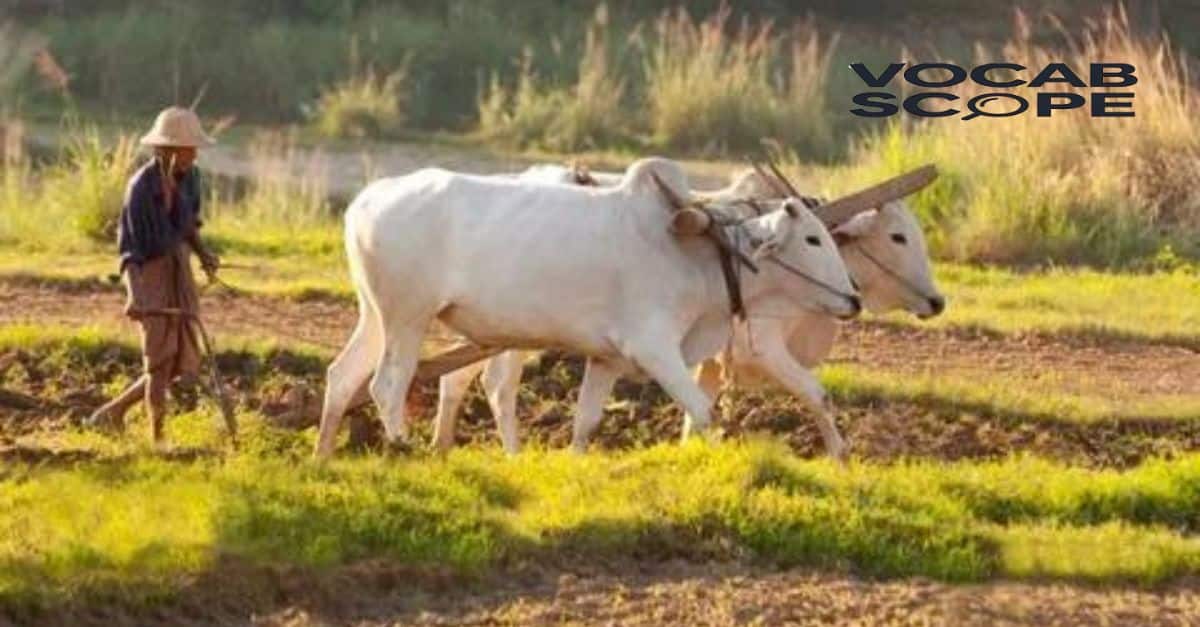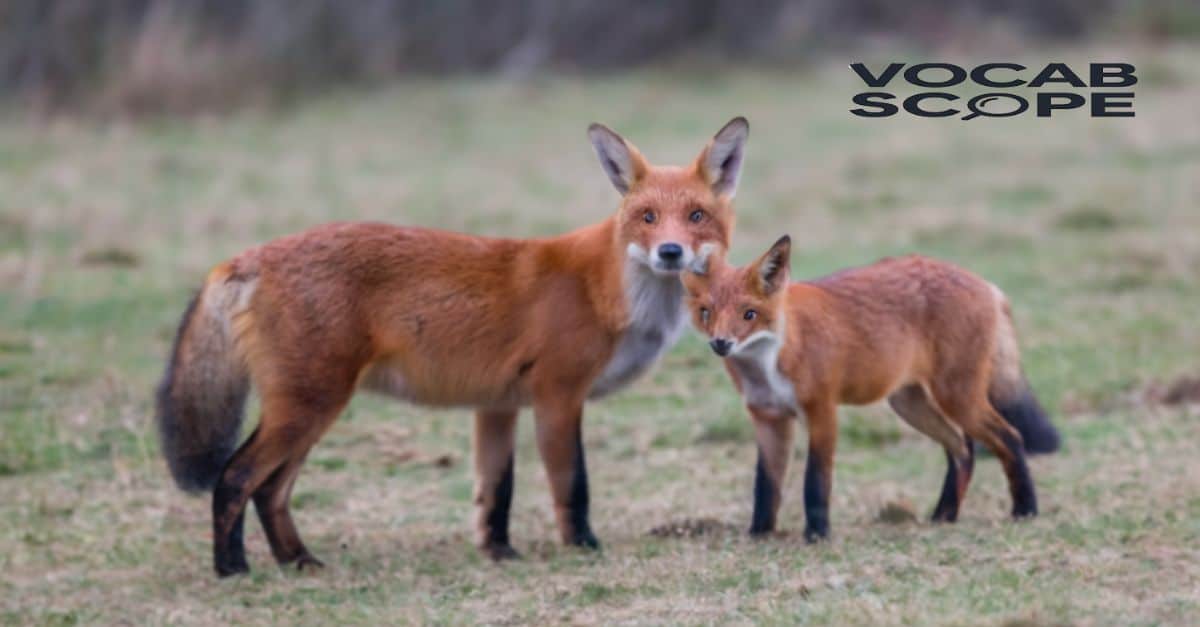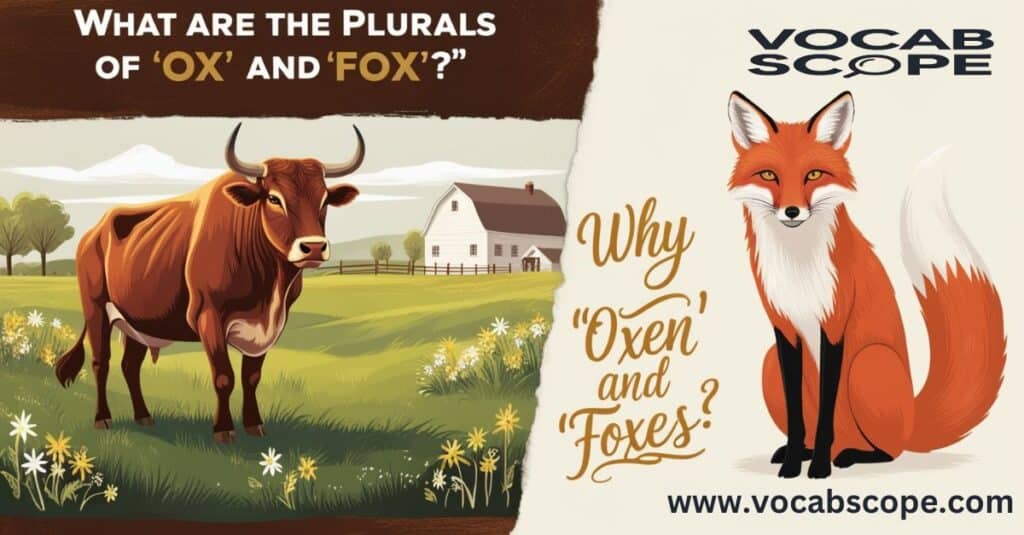When it comes to forming plurals in English, most words follow a simple rule—just add “-s” or “-es” to the end. But there are a few quirks in the language that don’t follow these patterns, and ‘ox’ and ‘fox’ are perfect examples.
The plurals for these animals, ‘oxen’ and ‘foxes’, stand out as exceptions that puzzle many. Why do we say “oxen” but not “foxen”? Let’s dive into this linguistic oddity to uncover the reasons behind these special Plurals of ‘Ox’ and ‘Fox’
Before we delve into the nitty-gritty, let’s take a quick look at what we’re dealing with:
| Singular | Plural |
| Ox | Oxen |
| Fox | Foxes |
Looks simple enough, right? But the journey to these plural forms is what makes English such a rich and complex language. Let’s break it down step by step.
Singular form: Ox and Fox
First things first, let’s get to know our subjects better.
Ox: The Gentle Giant
An ox is typically a castrated male cattle used for draft work. These big, strong animals have been helping humans for thousands of years. Picture a single big ox pulling a plow through a field—that’s the power we’re talking about! When considering the plurals of ‘ox’ and ‘fox’, remember that the plural of ox is oxen, reflecting its rich linguistic history.
“The ox is slow but the earth is patient.” – Chinese Proverb
Fox: The Clever Canine
A fox, on the other hand, is a clever member of the canine family. Known for their cunning and adaptability, foxes have made their homes in various environments across the globe. When discussing the plurals of ‘ox’ and ‘fox’, it’s important to note that foxes follow the regular English plural rule by adding “-es” to the singular form. When you think of a fox, you might imagine a single, sly creature sneaking through the underbrush, but in plural, these clever foxes showcase their adaptability in groups or as individuals.
Both these animals have special traits that make them stand out in the animal world. But when it comes to grammar, they stand out for a different reason – their unique plural forms.
Plurals form: Oxen and Foxes
When discussing the plurals of ‘ox’ and ‘fox’, we don’t simply add an “-s” for more than one ox; instead, we use the word oxen. Meanwhile, for foxes, the standard “-es” is applied, resulting in the plural form foxes. These two words illustrate the diversity and complexity of English plurals.
Oxen:

The plural oxen comes from Old English and follows a much older pattern of pluralization that we rarely see today. Historically, many English plural nouns were formed by changing the vowel sound or adding an ending like -en. This older way of forming plurals survives in a few words like oxen and children.
Example: “The farmer used strong oxen to plow the fields.”
Here’s a table comparing how the plural form of “ox” developed alongside other words that followed a similar pattern:
| Singular | Plural | Origin |
| Ox | Oxen | Old English |
| Child | Children | Old English |
| Brother | Brethren | Old English |
Although the plural of ox may seem strange today, it’s a remnant of a time when English words followed different pluralization rules.
Foxes:

In contrast, the word fox follows a more modern pluralization rule. Simply adding “-es” to make foxes fits the pattern we see with other singular forms ending in a sibilant sound (like “x”, “s”, “z”, or “ch”). This makes sense linguistically because adding just an “s” would be awkward to pronounce after the “x” sound.
Example: “We spotted several clever foxes hunting at dusk.”
Here’s a table to show how similar words are pluralized:
| Singular | Plural | Rule Applied |
| Fox | Foxes | Add -es after “x” |
| Box | Boxes | Add -es after “x” |
| Bush | Bushes | Add -es after “sh” |
So, while foxes fits the regular pattern for most plural forms, oxen represents a much older, more traditional English plural.
Comparing Plurals:
To further break down the quirks of these plural forms, let’s compare oxen and foxes side by side:
| Word | Singular | Plural | Reason for Pluralization |
| Ox | Ox | Oxen | Follows the older -en plural |
| Fox | Fox | Foxes | Follows modern -es plural rule |
This comparison shows the plural stuff in English can be tricky. While foxes falls into a modern pattern, oxen is a throwback to Old English grammar rules
Synonyms
| Word | Synonyms | Contextual Usage |
| Ox | Cattle, Bull, Steer, Bovine, Draught animal | Refers to domesticated bovine animals, often used for work. |
| Fox | Vulpine, Canine, Red fox, Vixen, Wild dog | Refers to wild, cunning animals, often in the canine family. |
| Oxen | Cattle, Bovine herd, Draught animals, Working cattle | Refers to plural forms of strong oxen used in farming or labor. |
| Foxes | Canines, Wild dogs, Vulpines, Predators | Refers to the plural form of the clever, small mammals. |
| Strong | Powerful, Sturdy, Robust, Resilient | Often used to describe the strength of oxen. |
| Cunning | Clever, Sly, Crafty, Deceptive | Frequently used to describe the intelligence and adaptability of foxes. |
Why ‘Foxes’ for ‘Fox’ and ‘Oxen’ for ‘Ox’?
The answer lies in the rich history of the English language. Let’s break it down:
The Case of ‘Foxes’
‘Foxes’ follows a regular plural pattern in modern English. Words ending in ‘-x’, ‘-s’, ‘-z’, ‘-ch’, or ‘-sh’ typically form their plurals by adding ‘-es’. This rule applies to many words:
- Box → Boxes
- Bus → Buses
- Buzz → Buzzes
- Church → Churches
- Bush → Bushes
So ‘fox’ becoming ‘foxes’ is actually quite straightforward. It’s just following the rules like a good little noun!
The Curious Case of ‘Oxen’
Now, ‘oxen’ is where things get interesting. This plural form is what we call an irregular plural. It doesn’t follow the typical rules of adding ‘-s’ or ‘-es’. Instead, it uses the ‘-en’ ending, which is a remnant of Old English.
In Old English, many nouns formed their plurals with ‘-en’:
- Eye → Eyen (now ‘eyes’)
- Shoe → Shoen (now ‘shoes’)
- Cow → Kine (now ‘cows’)
Over time, most of these plurals changed to the more common ‘-s’ or ‘-es’ endings. But a few stubborn words, like ‘ox’, held onto their old forms. Other examples include:
- Child → Children
- Brother → Brethren (in certain contexts)
So ‘oxen’ is like a living fossil in our language, a reminder of how English used to form plurals long ago!
Use in Context:
Oxen in Context:
- “The farmer relied on his strong oxen to pull the heavy cart through the muddy field.”
- In this sentence, the use of oxen highlights the strength of the animals, which are often used for hard labor on farms.
- “Historically, armies would use teams of oxen to transport supplies across long distances.”
- This example shows how oxen have been crucial for big, strong tasks, even in historical settings.
- “The plural form of ‘ox’ is oxen, not ‘oxes,’ because it follows an older English plural rule.”
- Here, the sentence directly explains the pluralization of oxen, making it educational.
Foxes in Context:
- “At dusk, we could see a group of clever foxes darting through the trees, hunting for their next meal.”
- The word foxes emphasizes the clever, cunning nature of these animals as they move swiftly and intelligently in the wild.
- “Despite their small size, foxes are known for their ability to adapt to various environments, including forests, deserts, and urban areas.”
- This sentence uses foxes in a way that highlights their resourcefulness and adaptability in different natural homes.
- “When it comes to plural forms in English, animals like foxes follow the regular rule of adding ‘-es’ to the end of the word.”
- This is an educational example that explains how the word foxes fits into the standard pluralization rule.
Comparative Context:
- “While the plural of ‘ox’ is oxen, following an older English rule, the plural of ‘fox’ is simply foxes, which fits the more modern method of pluralization.”
- This sentence directly compares oxen and foxes, explaining why they have different plural endings.
- “In the animal world, strong oxen are often associated with hard labor, while clever foxes are known for their quick thinking and agility.”
- Here, oxen and foxes are contrasted based on their roles and characteristics in nature.
By using these examples, it’s clear how oxen and foxes fit into everyday language, giving insight into the plural forms and their usage in both everyday conversation and more formal settings.
Conclusion:
The plurals of ‘ox’ and ‘fox’ reflect the quirky history of the English language. While oxen retains an ancient pluralization pattern from Old English, foxes follows the standard rule of adding “-es” that applies to most nouns today. Understanding these differences not only helps us use the correct plural forms but also gives us a glimpse into the fascinating history behind some of the quirks of the English language.
Strong oxen are still working on farms today, while clever foxes roam the forests and fields, both maintaining their place in the animal world with unique plural forms. Next time you’re talking about these animals, you can confidently use their correct plural names, appreciating the linguistic history that shaped them.

“Robert Henry is an experienced blogger with a passion for language and education. His insightful posts on Vocab Scope offer readers valuable tips on vocabulary and grammar. With a background in linguistics and a knack for clear, engaging writing, Robert is dedicated to helping others enhance their communication skills.”






